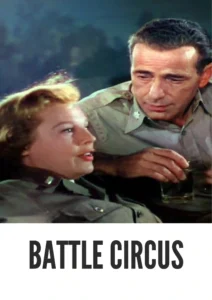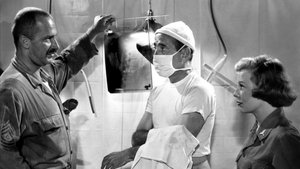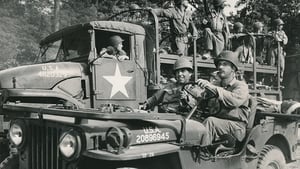Contact: info@alwanfilm.com
Video Sources 0 Views
- Watch trailer
- Battle Circus


Synopsis
Table of Contents
ToggleReview: Battle Circus 1953 Colorized – Analyzing the Impact of Early Colorization

Introduction
Released in 1953, Battle Circus offers a gripping portrayal of life during the Korean War, weaving together elements of drama, romance, and wartime action. Directed by Richard Brooks, this film has earned acclaim for its authentic depiction of the challenges faced by military personnel in the field. In this review, we’ll explore how the early colorization of Battle Circus 1953 influences the viewer’s perception of this wartime classic.
Check The Full Colorized Movies List
Check Our Colorized Movies Trailer Channel
Understanding Battle Circus 1953 Colorized: Director, Cast, and Genre
Directed by Richard Brooks, Battle Circus 1953 boasts a stellar cast, including Humphrey Bogart as the rugged and compassionate Major Jed Webbe and June Allyson as the dedicated Army nurse Lieutenant Ruth McGara. Set against the backdrop of the Korean War, the film blends elements of romance, drama, and wartime action to create a compelling narrative that resonates with audiences.
Exploring the World of Battle Circus 1953: Plot and Characters
Battle Circus 1953 follows the experiences of Major Jed Webbe and Lieutenant Ruth McGara as they navigate the challenges of providing medical care to wounded soldiers in a field hospital during the Korean War. As they confront the horrors of war and forge deep bonds with their comrades, they must also grapple with their own personal struggles and desires. Against the backdrop of a brutal and unforgiving conflict, they find solace and hope in each other’s arms.
The Art of Film Colorization
Film colorization has been a subject of debate in the world of cinema for decades. While some argue that it breathes new life into classic films and makes them more accessible to modern audiences, others contend that it detracts from the artistic integrity of the original work. Regardless of where one stands on the issue, early colorization techniques offer a fascinating glimpse into the evolving landscape of film preservation and restoration.
Early Colored Films: A Brief History
The history of early colored films is as varied as the colors themselves. From hand-painted frames to pioneering technicolor techniques, filmmakers have long sought to capture the vibrancy of the world on celluloid. While early color processes were often crude and labor-intensive, they laid the groundwork for the dazzling visual effects and digital wizardry that define modern cinema.
Battle Circus 1953 and Its Early Colored Version
The decision to release Battle Circus 1953 in a colorized format was met with both anticipation and skepticism. While some saw it as an opportunity to breathe new life into a wartime classic, others worried that it would detract from the film’s gritty realism and wartime atmosphere. Ultimately, whether one prefers the original black and white version or the colorized edition is a matter of personal preference. However, the colorized version offers a fresh perspective on Battle Circus 1953, allowing audiences to see familiar scenes in a new light and perhaps discover new depths to the film’s visual and emotional impact.
The Debate Over Film Colorization
The debate over film colorization continues to rage on, with proponents praising its ability to make classic films more accessible to modern audiences and opponents arguing that it compromises the artistic integrity of the original work. While there may never be a clear consensus on the issue, one thing is certain: early colorization techniques offer a fascinating glimpse into the evolving landscape of film preservation and restoration.
Examining Battle Circus 1953 as an Early Colored Film
Viewing Battle Circus 1953 in its early colorized iteration offers a unique viewing experience. While the colorization adds a layer of visual richness to the film, some may argue that it detracts from the gritty realism and wartime atmosphere of the original black and white version. However, others may appreciate the opportunity to see familiar scenes in a new light, with vibrant colors enhancing the film’s visual and emotional impact. Ultimately, whether one prefers the original black and white version or the colorized edition is a matter of personal preference.
Influence and Legacy: Battle Circus 1953’s Impact on Cinema
Battle Circus 1953 may not be as well-known as some of its contemporaries, but its impact on the cinematic landscape is undeniable. With its compelling narrative, standout performances, and timeless themes, the film has earned its place in the annals of cinematic history, inspiring filmmakers and audiences alike for generations to come.
Director’s Cinematic Legacy: Beyond Battle Circus 1953 Colorized
Richard Brooks’ directorial legacy extends far beyond Battle Circus 1953. Throughout his career, he pushed the boundaries of conventional filmmaking, tackling a wide range of genres and subjects with equal aplomb. His bold storytelling and keen eye for detail have left an indelible mark on the world of cinema, influencing countless filmmakers and captivating audiences around the globe.
Themes Explored in Battle Circus 1953 Colorized
At its core, Battle Circus 1953 explores themes of courage, sacrifice, and the human cost of war. Through its compelling narrative and richly drawn characters, the film offers a poignant meditation on the horrors of conflict and the resilience of the human spirit.
Reception and Controversy Surrounding Battle Circus 1953 Colorized
The release of the colorized version of Battle Circus 1953 sparked a flurry of debate among critics and audiences alike. While some praised the film’s newfound visual splendor, others lamented the loss of its gritty wartime atmosphere. Despite the controversy, the film remains a compelling testament to the power of storytelling and the enduring appeal of classic cinema.
Where to Watch Battle Circus 1953 Colorized Online
For those eager to experience Battle Circus 1953 for themselves, the film is readily available on popular streaming platforms such as Netflix, Amazon Prime, and Hulu. Whether viewed in its original black and white format or its early colorized iteration, Battle Circus 1953 continues to captivate audiences with its compelling narrative and richly drawn characters, cementing its status as a true classic of the silver screen.
FAQs About Battle Circus 1953 Colorized
1. Is Battle Circus 1953 based on a true story?
Battle Circus 1953 is a work of fiction inspired by real-life events and experiences. While the film’s storyline is not directly based on a specific true story, it draws inspiration from the challenges faced by military personnel during the Korean War to craft its compelling narrative.
2. Who directed Battle Circus 1953?
Battle Circus 1953 was directed by Richard Brooks, a visionary filmmaker known for his uncompromising vision and bold storytelling. Brooks’ masterful direction and the film’s authentic depiction of wartime experiences elevate it to cinematic greatness, making it a standout example of his directorial prowess.
3. What is the central conflict of Battle Circus 1953?
At its core, Battle Circus 1953 revolves around the central conflict between duty and desire. As Major Jed Webbe and Lieutenant Ruth McGara navigate the challenges of providing medical care in a war zone, they must also confront their own personal struggles and desires, testing their commitment to their duty and each other.
4. What sets Battle Circus 1953 apart from other wartime dramas of its time?
Battle Circus 1953 stands out from other wartime dramas of its time due to its authentic depiction of life on the front lines during the Korean War. Director Richard Brooks’ keen eye for detail and the film’s compelling narrative elevate it above typical war films, offering audiences a nuanced portrayal of the human cost of conflict.
5. What is the significance of the film’s early colorized version?
The early colorized version of Battle Circus 1953 offers audiences a fresh perspective on a classic wartime drama, allowing them to see familiar scenes in a new light. While some purists may prefer the original black and white version, the colorized edition provides an opportunity to experience the film’s gritty atmosphere and wartime action in a new way, with vibrant colors enhancing the visual and emotional impact of the story.
6. How does the colorization process affect the film’s visual aesthetic?
The colorization process adds a layer of visual richness to Battle Circus 1953, enhancing the film’s overall visual appeal. However, some purists argue that it detracts from the gritty realism and wartime atmosphere of the original black and white version. Ultimately, whether one prefers the original black and white version or the colorized edition is a matter of personal preference.
7. What is the legacy of Battle Circus 1953?
Battle Circus 1953 may not be as well-known as some of its contemporaries, but its impact on the cinematic landscape is undeniable. With its compelling narrative, standout performances, and timeless themes, the film has earned its place in the annals of cinematic history, inspiring filmmakers and audiences alike for generations to come.
8. Are there any sequels or remakes of Battle Circus 1953?
While there are no direct sequels or remakes of Battle Circus 1953, the film has inspired numerous works of art across various mediums, including literature, television, and music. Its influence can be seen in everything from gritty war dramas to thought-provoking character studies, cementing its status as a true classic of the silver screen.
9. Where can I watch Battle Circus 1953 online?
For those eager to experience Battle Circus 1953 for themselves, the film is readily available on popular streaming platforms such as Netflix, Amazon Prime, and Hulu. Whether viewed in its original black and white format or its early colorized iteration, Battle Circus 1953 continues to captivate audiences with its compelling narrative and richly drawn characters, cementing its status as a true classic of the silver screen.
Conclusion
In conclusion, Battle Circus 1953 remains a captivating classic of wartime cinema, regardless of its colorized iteration. While the debate over film colorization continues to rage on, one thing remains clear: Richard Brooks’ bold direction and compelling storytelling elevate Battle Circus 1953 to cinematic greatness. Whether viewed in its original black and white format or its early colorized version, the film continues to captivate audiences with its gripping narrative and authentic portrayal of wartime experiences, leaving a lasting impression that transcends time and space.
As audiences continue to revisit this cinematic gem for generations to come, its legacy will endure, inspiring countless filmmakers and captivating audiences with its timeless exploration of duty, sacrifice, and the human spirit. Ultimately, the choice of whether to watch Battle Circus 1953 in black and white or colorized format is a matter of personal preference. However, what remains undeniable is the film’s ability to enthrall and engage audiences, making it a true classic of wartime cinema.












